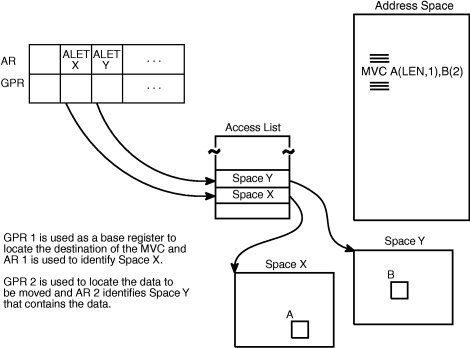After your program has an entry on an access list and the ALET
that indexes the entry, it must place a value in an AR before it can
use the data space. To understand how the system resolves addresses
in instructions for programs in AR mode, see Figure 1. This
figure shows how an MVC instruction in AR mode moves data from location
B in one data space to location A in another data space:
Figure 1. Using
Instructions in AR Mode

GPR 1 is used as a base register to locate the destination of the data, and AR 1 is used to identify space X. GPR 2 is used to locate the source of the data, and AR 2 identifies Space Y. In AR mode, a program can use a single MVC instruction to move data from one address/data space to another. Note that the address space that contains the MVC instruction does not have to be either Space X or Space Y.
In similar ways, you can use instructions that compare, test-under-mask, copy, move, and perform arithmetic operations.
When the instructions reference data in the primary address
space, the ALET in the AR must indicate that the data is in that address
space. For this purpose, the system provides a special ALET with
a value of zero. Other than using this value to identify the primary
address space, a program should never depend on the value of an ALET.
An ALET of zero designates the primary address space.
Loading the value of zero into an AR shows several examples of loading a value of zero in an AR.